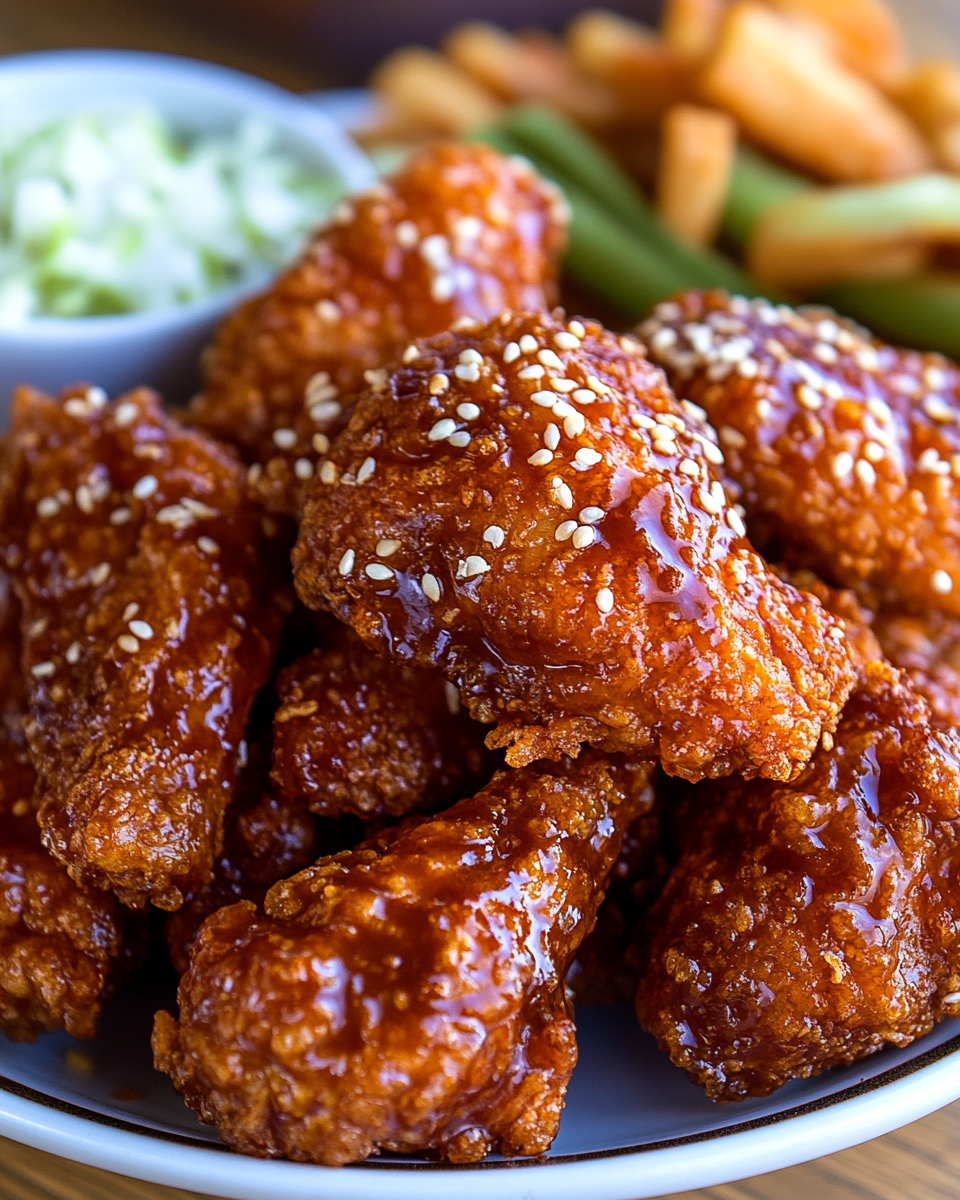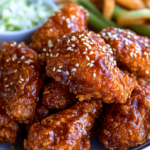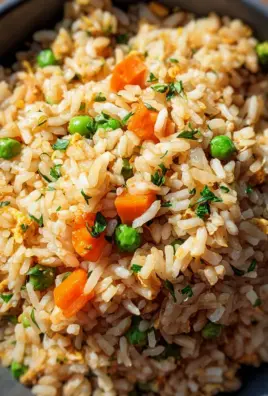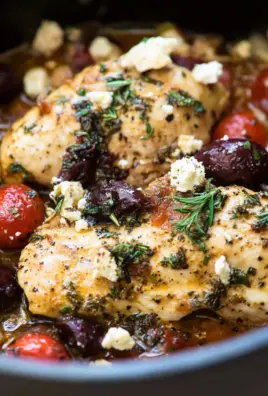Korean Fried Chicken (Yangnyeom Chicken) delivers a perfect balance of bold Korean flavors, ultra-crispy texture, and a sticky-sweet, spicy glaze. Unlike traditional Western fried chicken, Korean-style wings are double-fried for maximum crunch and coated in a deeply flavorful sauce that brings heat, sweetness, and umami all in one bite.

This recipe brings restaurant-level yangnyeom chicken into your kitchen using ingredients available at most grocery stores or Asian markets. The wings are seasoned, battered, fried twice, and then tossed in a fiery red glaze made with gochujang, a fermented Korean chili paste known for its depth and spice.
Whether you’re hosting a game day, family dinner, or casual weekend feast, Korean Fried Chicken (Yangnyeom Chicken) will be the dish that disappears first. It’s savory, spicy, crispy, and addictive.
Why You’ll Love This Recipe
- Authentic flavor with accessible ingredients
- Crispy coating thanks to the double-fry method
- Bold sauce that hits sweet, spicy, tangy, and umami notes
- Perfect for any occasion – party platter, appetizer, or main course
Preparation Phase & Tools to Use
Before you start cooking, prepare your ingredients and gather your equipment. Advance prep like dry brining and pre-making the sauce can streamline the cooking process and boost flavor.
Essential Tools and Equipment
- Deep fry thermometer – ensures precise oil temperature for a consistent fry
- Mixing bowls – for seasoning, battering, and sauce
- Whisk – for blending wet batter and sauce
- Tongs – for safe frying and flipping
- Wire rack and sheet pan – essential for draining fried chicken
- Medium saucepan – for simmering the sauce
Importance of Each Tool
Maintaining the right oil temperature is critical for crispy chicken. A thermometer removes guesswork. A wire rack prevents soggy coating by allowing air to circulate under the chicken after frying. Tongs and a deep pot provide safety and control while frying.
Preparation Tips
- Dry brine the chicken to enhance flavor and improve crispiness
- Use potato starch for the batter to create a thin, crackly crust
- Keep wet batter ingredients cold to preserve air bubbles
- Double-fry: First fry cooks the meat, second fry crisps the coating
- Rest chicken between fries to allow residual moisture to evaporate
Ingredients
For the Chicken
- 2 lbs chicken wings and drumettes (about 16 pieces)
- Peanut oil (or canola/vegetable oil), for frying
- 1 tsp sesame seeds, for garnish
Chicken Seasoning
- 1½ tsp salt
- 1 tsp garlic powder
- ½ tsp black pepper
- 1 tbsp cayenne pepper (optional, for heat)
Dry Batter
- ½ cup potato starch
- ¼ cup all-purpose flour
- 1 tsp chicken bouillon
- 1 tsp salt
- 1 tbsp cayenne pepper (optional)
Wet Batter
- ½ cup potato starch
- ¼ cup all-purpose flour
- 1 egg
- 1 tsp baking powder
- ½ cup cold club soda (or cold water)
Yangnyeom Sauce
- ¼ cup ketchup
- ¼ cup extra spicy gochujang
- ¼ cup rice syrup
- ¼ cup water
- 3 tbsp soy sauce
- 3 tbsp sugar
- 2 tsp plum vinegar (or rice/rice wine vinegar)
- 1 tsp gochugaru (Korean red chili flakes)
- 1 tbsp neutral oil
- 3 garlic cloves, minced
Step-by-Step Directions
1. Season the Chicken
Pat the chicken dry. In a large bowl, combine salt, garlic powder, black pepper, and optional cayenne. Rub evenly over the chicken. Dry brine uncovered in the refrigerator overnight or let sit at room temperature for 1 hour.
2. Make the Yangnyeom Sauce
In a saucepan over medium-low heat, sauté minced garlic in neutral oil until fragrant. Add ketchup, gochujang, rice syrup, water, soy sauce, sugar, vinegar, and gochugaru. Stir frequently as the sauce bubbles gently for 2–3 minutes. Remove from heat. This sauce can be made ahead and stored in the fridge.
3. Prepare the Batters
In one bowl, mix dry batter ingredients: potato starch, flour, bouillon, salt, and cayenne. In a second bowl, whisk together the wet batter ingredients: potato starch, flour, egg, baking powder, and cold club soda.
4. Coat the Chicken
Dip each wing into the wet batter, letting excess drip off. Dredge in the dry batter, pressing it on to ensure a thorough coat. Shake off any loose flour.
5. First Fry
Heat oil in a deep pot to 350°F. Fry chicken in batches for 6–8 minutes, depending on size. Maintain oil between 320–335°F. Remove and place on a wire rack.
6. Second Fry
Increase oil temperature to 370°F. Fry chicken again for 1 minute until golden brown and ultra-crispy. Keep the oil above 350°F throughout.
7. Sauce and Finish
While hot, toss chicken in the yangnyeom sauce or brush on for a lighter coat. Sprinkle with toasted sesame seeds.
8. Serve
Serve immediately. For the full experience, pair with pickled radish, shredded cabbage slaw, and a cold beer.
Serving Suggestions
Korean Fried Chicken (Yangnyeom Chicken) is incredibly versatile. While it’s often served as a main dish, it’s also a popular bar snack or appetizer in Korean dining culture. Here are some excellent ways to serve it:
- Traditional Korean Pairing: Serve alongside chicken-mu (pickled radish). Its crisp, tangy flavor balances the richness of the fried chicken and cuts through the spice.
- Cabbage Slaw: A simple shredded cabbage salad with a light vinaigrette or creamy dressing helps provide freshness and texture contrast.
- Ice-Cold Beer or Soju: Korean fried chicken is a popular companion to beer, often referred to as chimaek (chicken + maekju, the Korean word for beer).
- Lettuce Wraps: Serve the wings with perilla or romaine leaves, thinly sliced garlic, and ssamjang. Diners can create their own wraps with chicken, rice, and fresh veggies.
- Steamed Rice: Keep it simple and satisfying by offering hot steamed white rice on the side to mellow out the heat from the sauce.
- Korean Pickles: Aside from radish, you can also serve pickled cucumbers or kimchi to enhance the umami and add crunch.
These additions round out the flavor profile and transform this dish into a well-balanced meal.
Common Mistakes to Avoid
Even experienced cooks can run into a few issues when making Korean Fried Chicken (Yangnyeom Chicken). To get it right the first time, keep these tips in mind:
Skipping the Dry Brine
One of the most important steps is dry brining the chicken with salt and spices. This technique draws out moisture and helps season the meat deeply. Skipping this step often leads to bland chicken.
Using Room Temperature Batter
Cold batter is essential for creating a light, crispy coating. Warm batter leads to dense, oily crusts that don’t have the characteristic crackle of good Korean fried chicken.
Frying All at Once
Overcrowding your pot causes the oil temperature to drop, which results in soggy, greasy chicken. Always fry in small batches and let the oil recover between rounds.
Neglecting the Double-Fry
The second fry is not optional. It’s what gives Korean fried chicken its signature crunch. Skipping it will leave you with a softer, less satisfying texture.
Inconsistent Oil Temperature
Always monitor the oil with a thermometer. If it’s too low, the chicken absorbs excess oil. If it’s too high, the crust may burn before the inside is cooked.
Tossing Sauce Too Early
If the chicken isn’t hot enough when sauced, the glaze won’t cling well and may become gummy. Sauce the chicken immediately after the second fry for best results.
How to Perfect the Recipe
With a few expert techniques, your Korean Fried Chicken (Yangnyeom Chicken) will rival any restaurant version.
- Keep Ingredients Cold: The colder your wet batter, the more effective it will be at creating steam, which helps puff and crisp the coating.
- Use Potato Starch: It’s the key to creating a thin, shatteringly crisp shell. Cornstarch works, but it won’t give the same result.
- Let It Rest Between Fries: After the first fry, give the chicken a few minutes on a wire rack. This allows excess moisture to escape, which prevents sogginess.
- Brush vs. Toss: For a more uniform sauce coating, toss the chicken in a bowl. For a lighter touch, brush the sauce on each wing.
- Don’t Skip the Gochujang: This fermented chili paste is essential to the flavor. It provides not just heat but complexity and depth.
With the right process and attention to detail, this recipe will deliver exceptional flavor and crunch every time.
Side Dish Recommendations
The bold flavor of Korean Fried Chicken (Yangnyeom Chicken) calls for sides that either complement or contrast its richness. Here are eight fantastic options:
- Pickled Radish (Chicken-Mu)
A tangy, refreshing palate cleanser that’s practically mandatory. - Kimchi Fried Rice
Slightly sour, spicy, and packed with flavor, it makes a hearty companion to the chicken. - Japchae (Glass Noodles with Vegetables)
Sweet, savory, and chewy, this noodle dish adds variety in texture and flavor. - Spicy Korean Coleslaw
Crisp cabbage tossed in a gochugaru vinaigrette pairs perfectly with sauced wings. - Korean Corn Cheese
Sweet corn, melted cheese, and a touch of mayo create a creamy, gooey contrast. - Gyeran Mari (Rolled Egg Omelet)
Mild and soft, this dish balances out the spice and adds protein. - Steamed Rice with Furikake
Light and simple, it helps mellow the heat and round out the meal. - Tteokbokki (Spicy Rice Cakes)
Chewy and spicy-sweet, tteokbokki adds a hearty, comforting element.
These sides allow you to build a full Korean-style meal that’s dynamic, satisfying, and crowd-pleasing.
Recipe Tips for Perfect Korean Fried Chicken (Yangnyeom Chicken)
Even though the recipe is straightforward, there are several ways to take your fried chicken to the next level:
- Use a thermometer for accuracy
Oil temperature directly affects crispness. Keep it between 320°F–335°F for the first fry and 370°F for the second. - Always rest the chicken between fries
This allows steam and moisture to escape, which prevents sogginess and enhances crispness on the second fry. - Don’t overmix the wet batter
Light mixing ensures the batter remains airy, which contributes to the signature thin crust. - Make the sauce ahead of time
Preparing the yangnyeom sauce in advance allows the flavors to meld. Store it in the fridge for up to five days. - Brush if you prefer lighter flavor
Tossing the wings in sauce gives a deep glaze, but brushing allows better control of sweetness and spice. - Garnish with fresh sesame seeds
Toasted sesame seeds add nutty aroma and visual appeal, making your dish look complete.
Storage and Reheating Instructions
While Korean Fried Chicken (Yangnyeom Chicken) is best fresh, it can be stored and reheated properly to maintain quality.
Storing Leftovers
- Refrigerator: Store leftover fried chicken (unsauced if possible) in an airtight container for up to 3 days.
- Separate sauce: Keep any extra yangnyeom sauce in a sealed container in the fridge. This prevents the coating from becoming overly soft.
Reheating Instructions
- Oven method: Preheat your oven to 375°F. Place the chicken on a wire rack over a baking sheet and heat for 12–15 minutes.
- Air fryer method: Reheat at 375°F for 6–8 minutes, flipping once halfway through.
- Avoid microwaving: The microwave turns crispy chicken soggy and does not preserve texture.
Re-saucing
Once reheated, lightly warm the yangnyeom sauce in a saucepan or microwave, then brush or toss it over the chicken right before serving.
Frequently Asked Questions (FAQs)
These answers are based on common questions people ask about Korean Fried Chicken (Yangnyeom Chicken).
What makes Korean fried chicken different from American fried chicken?
Korean fried chicken is double-fried, which results in a thinner, crispier crust. The chicken is often sauced after frying, unlike American styles that are typically breaded or seasoned without sauce.
Why do you fry the chicken twice?
Double frying drives out moisture and ensures the crust stays crispy even after being coated in sauce.
Can I use boneless chicken?
Yes, boneless thighs work well. Cut them into chunks and follow the same frying and coating method. Adjust frying time slightly to avoid overcooking.
What is gochujang, and is it necessary?
Gochujang is a fermented Korean chili paste with spicy, sweet, and umami notes. It is essential for authentic yangnyeom sauce flavor. Substitutes like sriracha won’t replicate its complexity.
Can I air fry the chicken instead?
You can try, but results may vary. Air frying won’t give the same crispness as deep frying. If using this method, spray generously with oil and cook in batches.
How spicy is this dish?
Moderately spicy. You can reduce heat by using less gochujang or omitting cayenne and gochugaru.
Can I make this gluten free?
Yes. Use gluten-free flour in the batter and ensure your soy sauce and gochujang are certified gluten free.
Can I freeze Korean fried chicken?
Freezing is not recommended, as it affects the texture. However, you can freeze uncooked seasoned chicken and fry it fresh later.
What kind of oil is best for frying?
Use neutral, high-smoke-point oils like peanut, canola, or vegetable oil.
How do I keep the chicken crispy after frying?
Let it rest on a wire rack, not paper towels. Avoid covering it until ready to serve, as trapped steam softens the crust.
Conclusion
Korean Fried Chicken (Yangnyeom Chicken) is the perfect harmony of crunchy texture and bold flavor. The double-frying method gives it unmatched crispness, while the gochujang-based glaze delivers layers of sweet, spicy, and savory notes.
This dish is more than just fried chicken—it’s a cultural experience that brings the essence of Korean street food to your home kitchen. Whether you serve it with pickled radish and beer or pair it with rice and banchan, it’s a guaranteed crowd-pleaser.
Once you’ve made it yourself, you’ll understand why this dish has become a global favorite. Make it your own by adjusting the spice level, experimenting with boneless cuts, or pairing it with different Korean sides.
Looking for more Korean-inspired recipes? Try our Spicy Tteokbokki, Easy Homemade Kimchi, or Japchae Stir-Fry Noodles next.
Korean Fried Chicken (Yangnyeom Chicken)
Ingredients
For the Chicken:
- 2 lbs chicken wings and drumettes about 16 pieces
- Peanut oil or canola/vegetable oil, for frying
- 1 tsp sesame seeds for garnish
Chicken Seasoning:
- 1½ tsp salt
- 1 tsp garlic powder
- ½ tsp black pepper
- 1 tbsp cayenne pepper optional, for heat
Dry Batter:
- ½ cup potato starch
- ¼ cup all-purpose flour
- 1 tsp chicken bouillon
- 1 tsp salt
- 1 tbsp cayenne pepper optional
Wet Batter:
- ½ cup potato starch
- ¼ cup all-purpose flour
- 1 egg
- 1 tsp baking powder
- ½ cup cold club soda or cold water
Yangnyeom Sauce:
- ¼ cup ketchup
- ¼ cup extra spicy gochujang
- ¼ cup rice syrup
- ¼ cup water
- 3 tbsp soy sauce
- 3 tbsp sugar
- 2 tsp plum vinegar or rice vinegar or white vinegar
- 1 tsp gochugaru Korean red chili flakes
- 1 tbsp neutral oil
- 3 garlic cloves minced
Instructions
Season the Chicken:
- Pat the chicken wings dry. In a bowl, mix the salt, garlic powder, black pepper, and cayenne. Rub this seasoning all over the chicken. Dry brine uncovered in the refrigerator overnight or at room temperature for 1 hour.
Make the Yangnyeom Sauce:
- In a saucepan over medium-low heat, sauté the minced garlic in neutral oil until fragrant, but not browned. Add the remaining sauce ingredients and let it bubble gently for 2–3 minutes, stirring often. Remove from heat and set aside. This sauce can be made ahead and refrigerated.
Prepare the Batters:
- In one bowl, mix the dry batter ingredients: potato starch, flour, bouillon, salt, and optional cayenne.
- In a second bowl, mix the wet batter ingredients: potato starch, flour, egg, baking powder, and cold club soda or water.
Coat the Chicken:
- Dip each piece of chicken into the wet batter, letting the excess drip off. Then coat it in the dry batter, pressing it on and shaking off the excess.
First Fry:
- Heat oil in a deep pot to 350°F. Fry the chicken in batches for 6–7 minutes (or 7–8 minutes for larger pieces), maintaining the oil temperature between 320–335°F. Place the fried chicken on a wire rack to rest.
Second Fry:
- Reheat the oil to 370°F. Fry the chicken a second time for about 1 minute, ensuring the oil stays above 350°F. This step makes the coating extra crispy.
Sauce & Finish:
- While the chicken is hot, toss it in the prepared Yangnyeom sauce or brush it on evenly. Garnish with toasted sesame seeds.
Serve:
- Serve immediately with pickled radish, cabbage slaw, and a cold beer for the full Korean fried chicken experience.




Leave a Comment